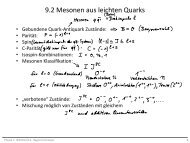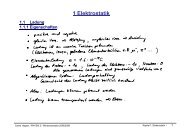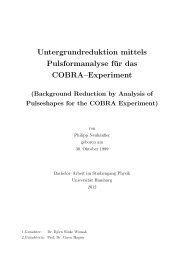Setup of a Drift Tube Muon Tracker and Calibration of Muon ...
Setup of a Drift Tube Muon Tracker and Calibration of Muon ...
Setup of a Drift Tube Muon Tracker and Calibration of Muon ...
Create successful ePaper yourself
Turn your PDF publications into a flip-book with our unique Google optimized e-Paper software.
Angular AcceptanceAngular AcceptanceP10.90.8nhit ≥ 3nhit ≥ 4P10.90.8nhit ≥ 3nhit ≥ 40.70.70.60.60.50.50.40.40.30.30.20.20.10.100 1 2 3 4 5 6ϕ00 0.2 0.4 0.6 0.8 1 1.2 1.4θFigure 5.6: Angular acceptance <strong>of</strong> the CMT for the azimuth angle ϕ (left) <strong>and</strong> thepolar angle θ (right). The number <strong>of</strong> events is normalized to events equally distributedin the trigger plane. The red line shows the relative number <strong>of</strong> events for the requirement<strong>of</strong> at least four hits per 2D array. The total number <strong>of</strong> events is significantlyenhanced by lowering this to three hits only.5.1.1 Angular Acceptance <strong>of</strong> the Modified <strong>Setup</strong>To analyze the angular acceptance <strong>of</strong> the modified setup, a simple simulation hasbeen used. Considering the new geometry <strong>of</strong> the detector, tracks were r<strong>and</strong>omly generatedin the trigger plane. No specific angular distribution was taken into account,both the azimuth <strong>and</strong> zenith angles <strong>of</strong> the tracks were generated homogeneously.For each track, the number <strong>of</strong> hit tubes in each 2D array was determined. Fig. 5.6shows the probability that a triggered event leaves at least three (four) hits in each2D array in dependence <strong>of</strong> the azimuth <strong>and</strong> polar angle. Fig. 5.7 shows the sameresults for a direct correlation <strong>of</strong> the polar <strong>and</strong> azimuth angle. The modified setupis sensitive to all azimuth angles, the sensitivity only varies a little in dependence <strong>of</strong>ϕ. The minimal required number <strong>of</strong> hits has no significant effect on the acceptancein ϕ. The total number <strong>of</strong> events improves significantly by a factor <strong>of</strong> almost two.However, looking at the polar angle distribution, this improvement mainly occursfor small values θ. The expected effect for real data will be smaller because theseevents are suppressed in realistic angular distributions due to the solid angle.5.1.2 Reconstruction with Three Hits OnlyTo study the effects <strong>of</strong> a reconstruction with three hits only, a real event samplewith four hits per event has been taken as a reference. Each event was modifiedso that only three hits remained, leaving four different combinations per event. Allcombinations were reconstructed <strong>and</strong> the resulting track parameters were comparedto the original reconstruction with four hits. The results show that 99.7% <strong>of</strong> thetracks are also reconstructed with only three hits. However, depending on the quality<strong>of</strong> the calibration, not all tracks are reconstructed correctly. Fig. 5.8 shows thedifference between the Hesse parameter α <strong>of</strong> both a reconstruction with four <strong>and</strong>three hits per plane. The distribution shows a clear peak around zero, which canbe fitted by a Gaussian. The σ <strong>of</strong> the fit is found to be 24 mrad. This can be takenas a rough estimate <strong>of</strong> the angular resolution for the reconstruction with three hitsonly. This value is approximately five times larger than the resolution found for74





